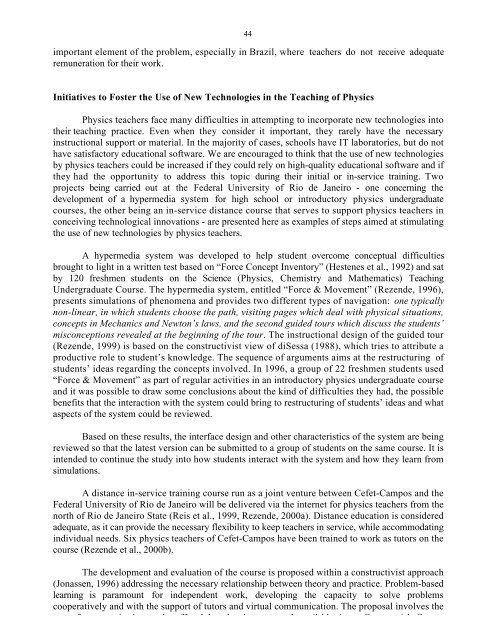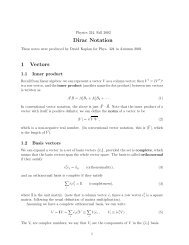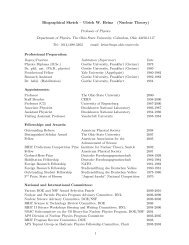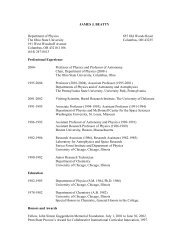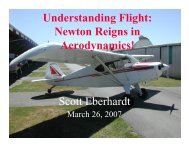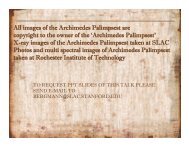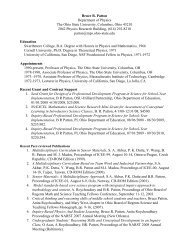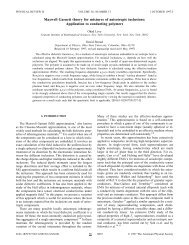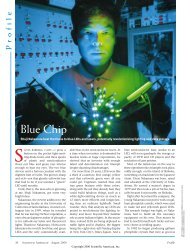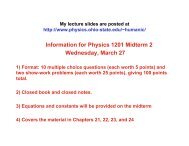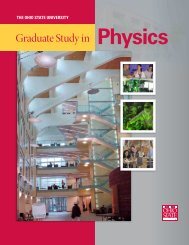Brasil Final Report - Department of Physics - The Ohio State University
Brasil Final Report - Department of Physics - The Ohio State University
Brasil Final Report - Department of Physics - The Ohio State University
Create successful ePaper yourself
Turn your PDF publications into a flip-book with our unique Google optimized e-Paper software.
44<br />
important element <strong>of</strong> the problem, especially in Brazil, where teachers do not receive adequate<br />
remuneration for their work.<br />
Initiatives to Foster the Use <strong>of</strong> New Technologies in the Teaching <strong>of</strong> <strong>Physics</strong><br />
<strong>Physics</strong> teachers face many difficulties in attempting to incorporate new technologies into<br />
their teaching practice. Even when they consider it important, they rarely have the necessary<br />
instructional support or material. In the majority <strong>of</strong> cases, schools have IT laboratories, but do not<br />
have satisfactory educational s<strong>of</strong>tware. We are encouraged to think that the use <strong>of</strong> new technologies<br />
by physics teachers could be increased if they could rely on high-quality educational s<strong>of</strong>tware and if<br />
they had the opportunity to address this topic during their initial or in-service training. Two<br />
projects being carried out at the Federal <strong>University</strong> <strong>of</strong> Rio de Janeiro - one concerning the<br />
development <strong>of</strong> a hypermedia system for high school or introductory physics undergraduate<br />
courses, the other being an in-service distance course that serves to support physics teachers in<br />
conceiving technological innovations - are presented here as examples <strong>of</strong> steps aimed at stimulating<br />
the use <strong>of</strong> new technologies by physics teachers.<br />
A hypermedia system was developed to help student overcome conceptual difficulties<br />
brought to light in a written test based on “Force Concept Inventory” (Hestenes et al., 1992) and sat<br />
by 120 freshmen students on the Science (<strong>Physics</strong>, Chemistry and Mathematics) Teaching<br />
Undergraduate Course. <strong>The</strong> hypermedia system, entitled “Force & Movement” (Rezende, 1996),<br />
presents simulations <strong>of</strong> phenomena and provides two different types <strong>of</strong> navigation: one typically<br />
non-linear, in which students choose the path, visiting pages which deal with physical situations,<br />
concepts in Mechanics and Newton’s laws, and the second guided tours which discuss the students’<br />
misconceptions revealed at the beginning <strong>of</strong> the tour. <strong>The</strong> instructional design <strong>of</strong> the guided tour<br />
(Rezende, 1999) is based on the constructivist view <strong>of</strong> diSessa (1988), which tries to attribute a<br />
productive role to student’s knowledge. <strong>The</strong> sequence <strong>of</strong> arguments aims at the restructuring <strong>of</strong><br />
students’ ideas regarding the concepts involved. In 1996, a group <strong>of</strong> 22 freshmen students used<br />
“Force & Movement” as part <strong>of</strong> regular activities in an introductory physics undergraduate course<br />
and it was possible to draw some conclusions about the kind <strong>of</strong> difficulties they had, the possible<br />
benefits that the interaction with the system could bring to restructuring <strong>of</strong> students’ ideas and what<br />
aspects <strong>of</strong> the system could be reviewed.<br />
Based on these results, the interface design and other characteristics <strong>of</strong> the system are being<br />
reviewed so that the latest version can be submitted to a group <strong>of</strong> students on the same course. It is<br />
intended to continue the study into how students interact with the system and how they learn from<br />
simulations.<br />
A distance in-service training course run as a joint venture between Cefet-Campos and the<br />
Federal <strong>University</strong> <strong>of</strong> Rio de Janeiro will be delivered via the internet for physics teachers from the<br />
north <strong>of</strong> Rio de Janeiro <strong>State</strong> (Reis et al., 1999, Rezende, 2000a). Distance education is considered<br />
adequate, as it can provide the necessary flexibility to keep teachers in service, while accommodating<br />
individual needs. Six physics teachers <strong>of</strong> Cefet-Campos have been trained to work as tutors on the<br />
course (Rezende et al., 2000b).<br />
<strong>The</strong> development and evaluation <strong>of</strong> the course is proposed within a constructivist approach<br />
(Jonassen, 1996) addressing the necessary relationship between theory and practice. Problem-based<br />
learning is paramount for independent work, developing the capacity to solve problems<br />
cooperatively and with the support <strong>of</strong> tutors and virtual communication. <strong>The</strong> proposal involves the<br />
use <strong>of</strong> communication tools <strong>of</strong>fered by the internet and available in a Commercial Course


